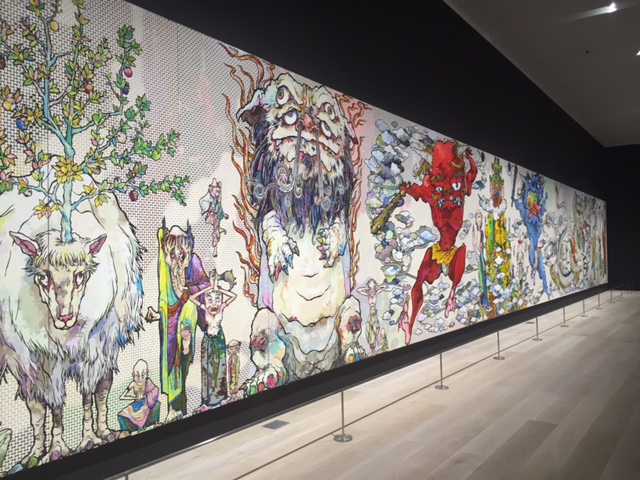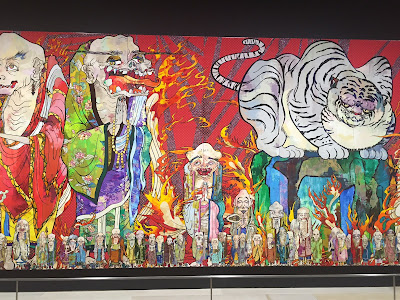If you live in an advanced economy, you will probably live until you are anywhere between 75 and 85 years of age. If you keep a healthy diet, stay active and maintain close and productive relationships with family and friends, you could probably live closer to 85 years of age. Life is not short for most of us - it's just 15 to 20 years short of a century! That's a long time...
It felt so good to be back on a mountain – tons of snow every day – the cold, clean air, the only sounds coming from the gentle swishing of skis and snowboards, followed by the occasional “Woooo HOOOOO” as someone would attempt a jump or conquer a slope with pure JOY. (my favorite word in the English language - JOY)
It was refreshing, meditative and having an “aha” moment of
“I can ski for the next 15 to 20 years if I keep fit” turned into another “aha”
moment of “OMG – Life is LONG!”…. This realization became artistically
therapeutic on so many levels.
Where life does come up short, however; are the many experiences and adventures we have. The short time I have left with our parents, or the short time I may have in learning something, experiencing a new culture, embarking on a new adventure is something to cherish and something to look forward to. More importantly, I have to make the most of it and simultaneously - slow down to enjoy the moments so I can savor each one later.
I just celebrated my 48th birthday on the ski
slopes of Hanazono Mountain in Niseko, Japan.
Why is this a big deal for me? I
hadn’t been skiing since a ski accident in Killington, Vermont left me with a
torn ACL (Anterior Cruciate Ligament) in my left knee – which required surgical
repair about 10 to 12 years ago. It was
a bit intimidating to get back on the slopes after so many years! Thankfully, I had a great instructor at the
Niseko International Ski School (Mark) who patiently “re-taught” me how to ski
with improved form and great tips. A
half-day lesson from an excellent teacher and my confidence was back! I skiied for 3 1/2 days with my husband and boys (boys snowboard, hubby skis) And now! I can’t wait to go skiing again and
am determined to stay in shape so I can (hopefully) ski into my 70s! OK – maybe that's ambitious - but if I shoot for 70 - maybe I can make it to 65?
 |
| An inactive volcano in Niseko - simply beautiful |
 |
| My husband tree-line skiing in the powder. |
 |
| A trail on Hanazono Mountain in Niseko, Japan. Snowing every day meant FRESH powder every morning! |
It felt so good to be back on a mountain – tons of snow every day – the cold, clean air, the only sounds coming from the gentle swishing of skis and snowboards, followed by the occasional “Woooo HOOOOO” as someone would attempt a jump or conquer a slope with pure JOY. (my favorite word in the English language - JOY)
 |
| A very sunny morning looking at the ski trails of Hirafu Mountain |
I realized I have time… I spent 20 years in my first career
and am grateful that I enjoyed it every day.
I can do the same as I start my artistic career... whatever that ends up
looking like. And – because life is long
– I get to enjoy it and look forward to it for at least the couple decades!
Where life does come up short, however; are the many experiences and adventures we have. The short time I have left with our parents, or the short time I may have in learning something, experiencing a new culture, embarking on a new adventure is something to cherish and something to look forward to. More importantly, I have to make the most of it and simultaneously - slow down to enjoy the moments so I can savor each one later.
My Oil/Drawing Instructor is a wonderful woman in her late
60s, she is inspirational to me because she is fit, active, and doing
what she loves – painting and teaching.
I have been under her tutelage for the past 3 years and love it. Living in Tokyo has allowed me the
opportunity to study under her. My time
with learning the art of Sumi-E (Japanese brush painting) is even more urgent
while I am here in Tokyo. I can’t depend
that upon my return to the US I will find such excellent instruction from such
talented Sumi-E artists. (see previous blog post The Art of the Japanese
Brush).
And so, not exactly sure of the time I have left here in
Tokyo – I am determined to make the most of the experience and learn as much as
I can from my amazing Senseis (teachers), across photography, painting and drawing. I also want to make sure I enjoy the friends I have made here before we all move on to our next assignments...
So, what is the moral of this blog post? Life is longer than we think. So, have a plan. Take your time. You don’t have to have it all – all at
once. But! You can have it all across
your lifetime. You can have children,
and work, and volunteer, and go back to school, and have a second career, and try a new hobby. One of my dear friends worked in Corporate Finance, stayed home to raise her children, went back to school and is now in her second career as a teacher. I have two others who have also "re-started" their careers in new and different roles. Maria
Shriver (John F. Kennedy's niece) said it best on American TV News Magazine, The Today Show, many years ago… and it went something
like this… “I can have a career in my 20s, be a mother and wife in my 30s and
be an author in my 40s…” (She wrote a book in her 40s and is still working in Journalism.)
In the meantime; we have to take the time to care for
ourselves – physically and mentally – so that we can take full advantage of
each adventure. For me, that means staying fit and making sure I eat well. (i.e. some
chocolate – and more veggies!)
I have always had a bucket list of things I wanted to
accomplish in life – I have been fortunate to be presented with unexpected
opportunities where I can accomplish things that seemed so out of reach when I
was a teenager. Who knew that traveling
to Vietnam and Cambodia would be possible 35 years ago! And I never thought I would live in Japan. While I was on the slopes and experiencing that "endorphin high" and "aha moment" - I added re-starting piano lessons and maybe trying out some guitar whenever we make it back to the States... hell; maybe I'll even write music again! (I used to sing, play the piano, violin and write lyrics - but that's a whole other blog post at a different time). I also figured out the theme for my first exhibition... (crossing fingers!)
For now, thanks to an excellent ski instructor and my family
for encouragement I can cross off an item on my bucket list!
Getting back on the slopes to ski!
Until my next post!
(With) PEACE. (In) ART. (To the) SOUL.
Rajul
Back to my webpage
Always - I love hearing from you and your thoughts, ideas on future posts. Please feel free to leave me comments below!
Rajul
Back to my webpage
Always - I love hearing from you and your thoughts, ideas on future posts. Please feel free to leave me comments below!













